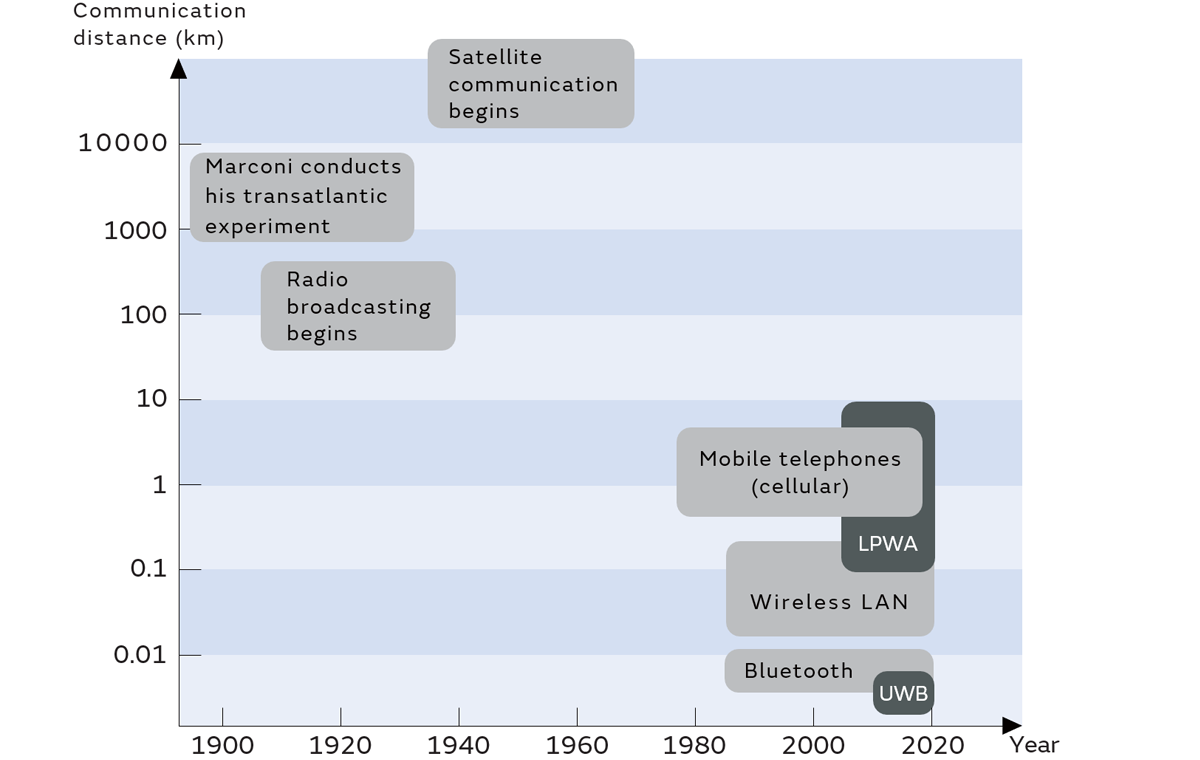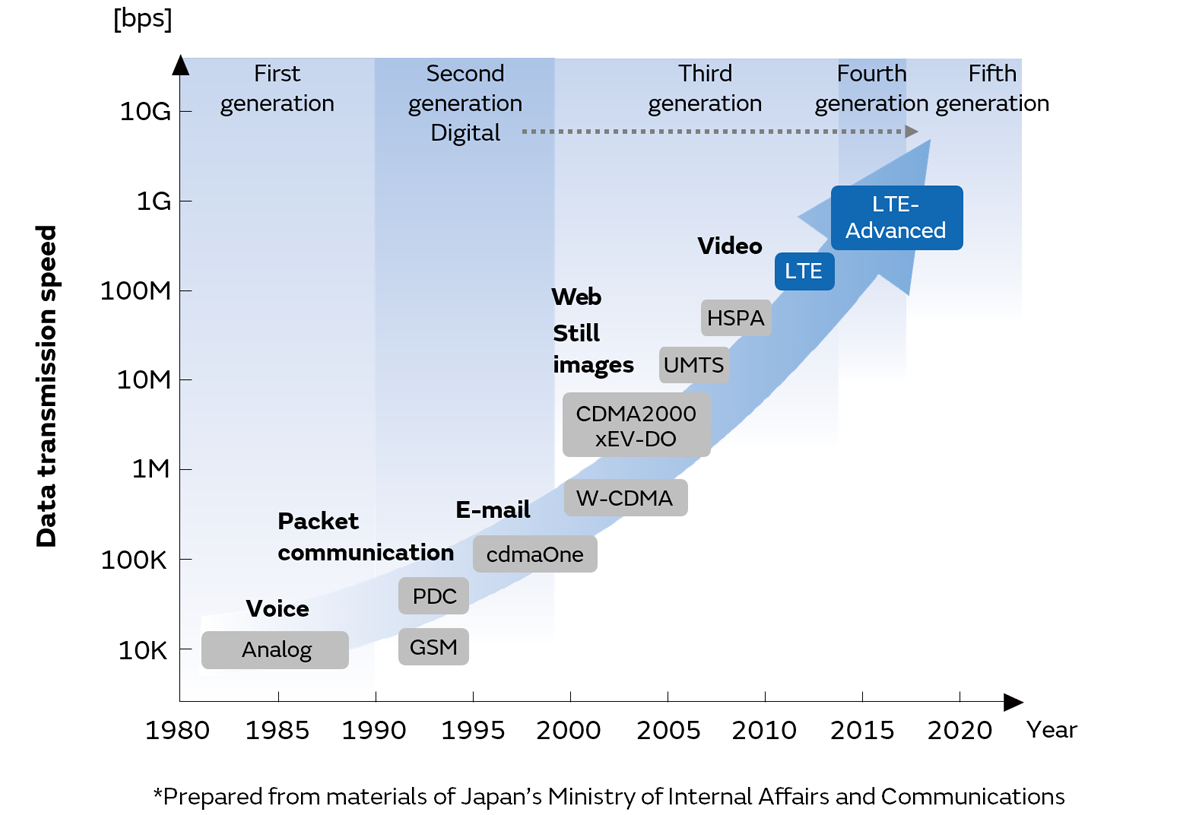Connectivity Modules


1. What Is Wireless Communication?
2. Examples of Wireless Communication Applications
3. Basic Configuration and Elements of Wireless Communication Systems
4. Wireless Communication Method: Modulation and Demodulation
Column: Radio Waves and Their Frequencies
Index: Wireless Mechanism (2)
5. Data Transmission Direction: Duplex (Full Duplex and Half-duplex) and Simplex
The transmission format in terms of in which direction the data is transmitted is an important specification in communication applications regardless of whether wireless or wired. That format is divided into duplex transmission and simplex transmission. Moreover, duplex transmission can be further classified into full-duplex transmission and half-duplex transmission. We explain each transmission method below.
Duplex transmission*5 is a transmission format that appears to have been adopted in a very large percentage of current digital communication devices. There are two types of duplex transmission: full-duplex transmission and half-duplex transmission.
As shown in Fig. 8-1, full-duplex transmission is a transmission format that enables data communication and voice calls in two ways (duplex) at the same time: from device A to device B and from device B to device A. If the received and transmitted (sometimes described respectively as “Rx” and “Tx”) signals are assigned different frequencies, the electronic components in orange that separate these are called duplexers.
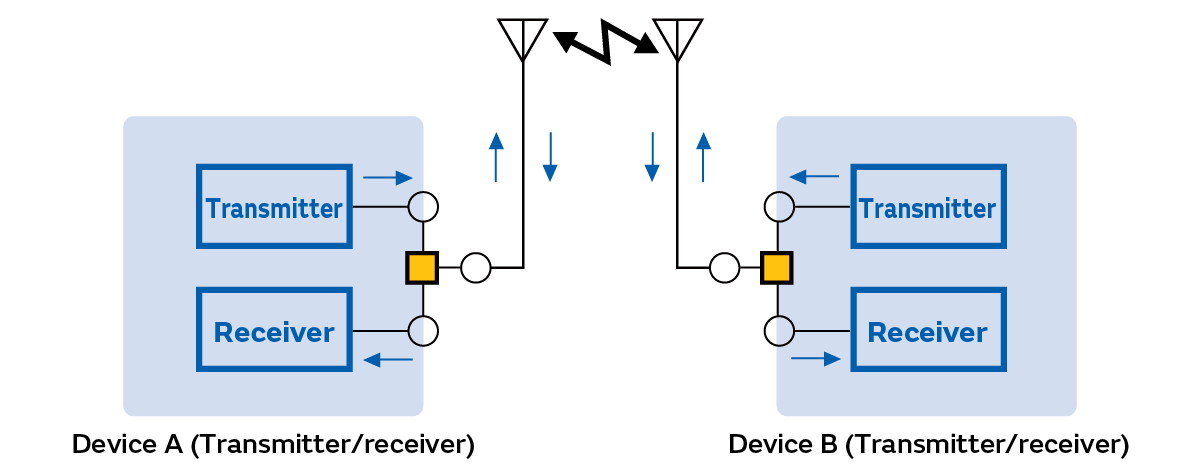
Application examples: landline telephones, mobile phones, smartphones, etc. (direct connection between devices)
*5: We often hear the terms download/upload and downlink/uplink in relation to duplex transmission. Let’s say the terminal or PC you are using is device A. In this case, receiving data from device B is called a download; conversely, transmitting data from device A to device B is called an upload. Moreover, when it is simply the connection between device A and device B—for example, a connection with a terminal and base station—that is important instead of the data transmission itself, it is called a downlink/uplink.
As shown in Fig. 8-2a and Fig. 8-2b, half-duplex transmission is a format in which device A and device B transmit data by mutually switching between transmitting and receiving. This format is distinguished from full-duplex transmission because data cannot be transmitted in two ways at the same time.
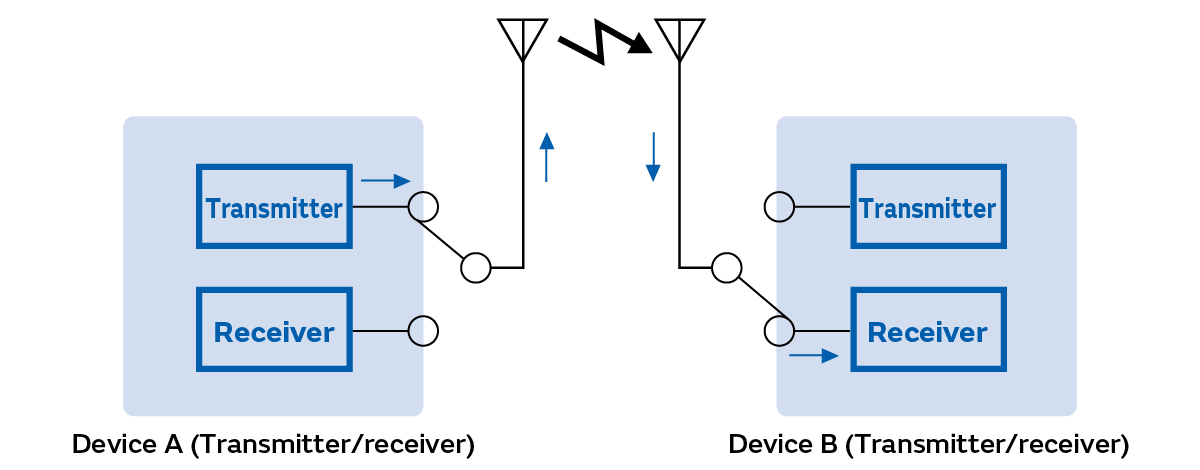
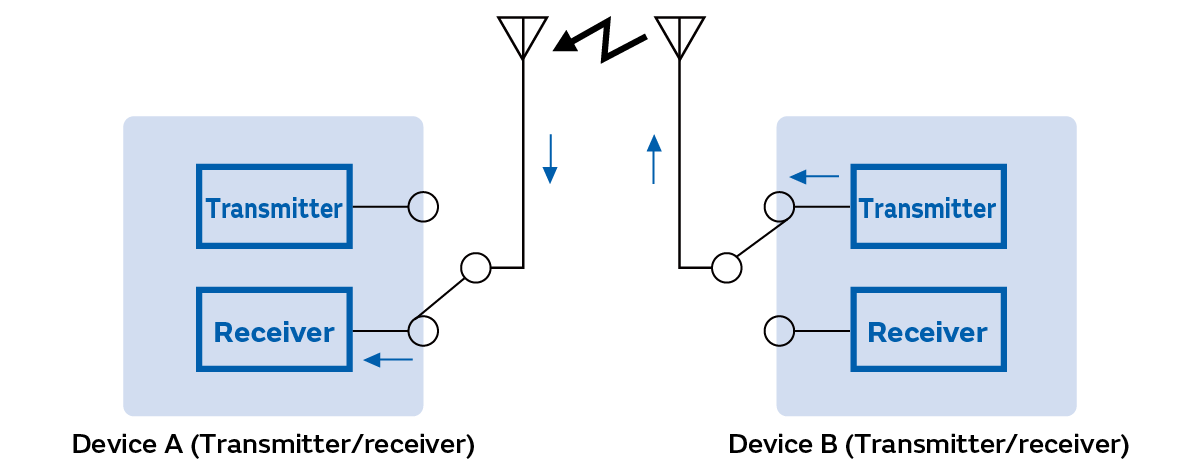
Application example: Transceivers
As shown in Fig. 8-3, simplex transmission is a format in which data is transmitted between device A (transmitter) and device B (receiver) only in one direction (simplex), from device A to device B.
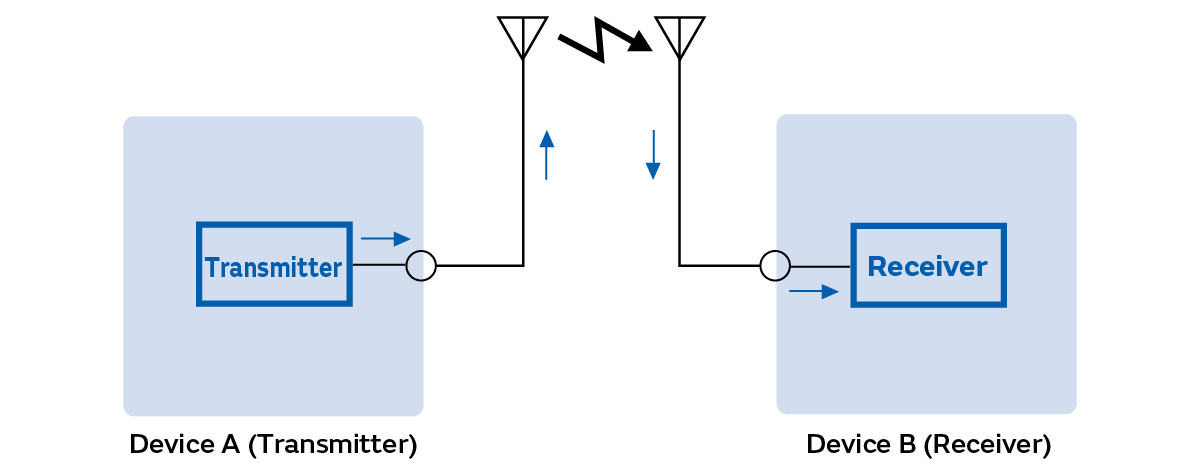
Application examples: AM/FM radio broadcasting, remote control using radio waves, etc.
So far, we have given an overview of wireless communication from the hardware aspect. On the other hand, the software aspect is also important to establish telecommunication regardless of whether wireless or wired. This software is called the communication protocol, or simply protocol.
A protocol refers to procedures and rules determined to, for example, mutually transmit data without errors between differing systems in data communication (digital communication) systems, including computers. Figure 9 shows an example of the role of protocols relating to data transmission.
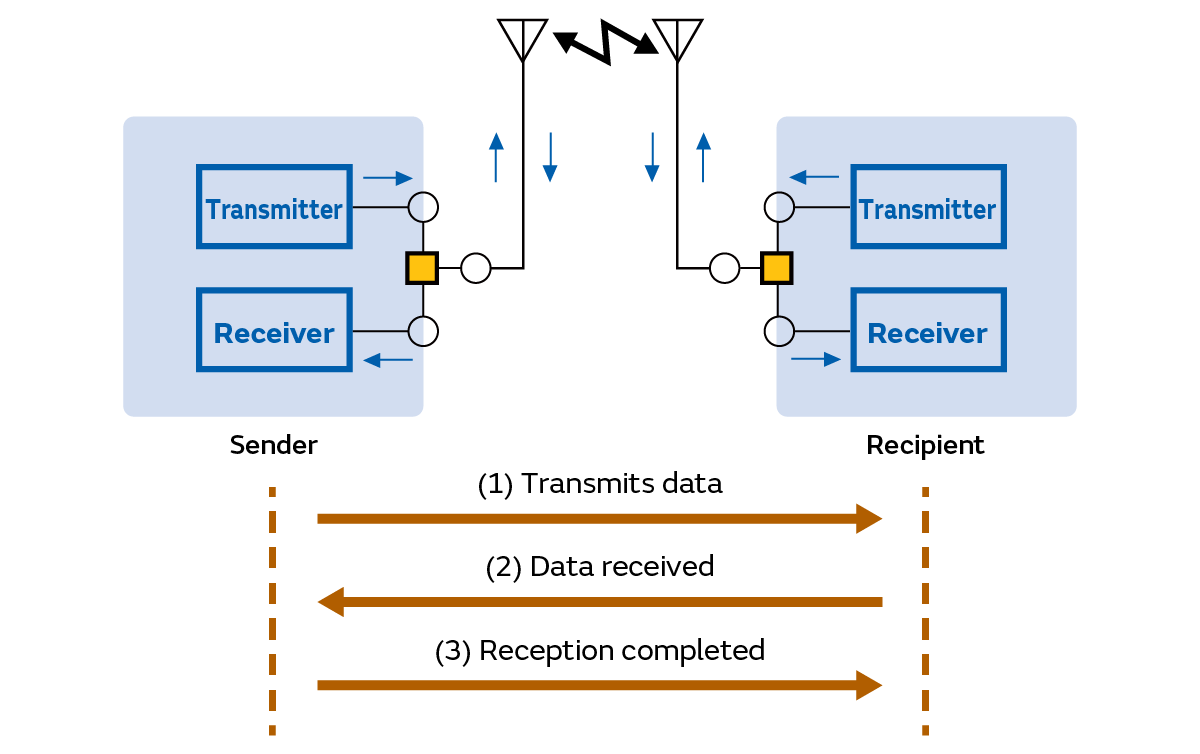
It is necessary to determine a wide range of role and function protocols such as the control procedures, data structures, and interfaces to ensure the transmission of data. However, that involves a huge number of protocols. Let’s say that a protocol is fixed to one model. In that case, when it becomes necessary to update the protocol such as by adding contents to it or changing its contents, it is difficult to deal with that. Accordingly, each role and function are assigned a protocol and then those protocols are organized into a layered structure to ensure that they can be updated easily. This systematically organized protocol structure is called a protocol stack. (It is also sometimes called a protocol suite or network architecture.)
The protocol stack is modeled on international standards. This is called the open systems interconnection (OSI) basic reference model (Table 4). In practice, this model is not used; instead, a protocol stack with specifications convenient for each application (good data transmission efficiency and high data transmission reliability, etc.) is adopted. Table 5 describes the correspondence between the TCP/IP model used as standard on the Internet and the OSI basic reference model taking the protocol stack in the Bluetooth® LE model as the example. We have omitted an explanation on each layer in the TCP/IP model and Bluetooth® LE model. You can see that the number of layers is small and that some layers have been omitted.
The mechanism is such that 4G LTE and 5G communication goes via a base station. Therefore, their communication protocols are becoming more complicated than the TCP/IP model and Bluetooth® LE model.


The history of wireless communication goes back to 1864. British theoretical physicist J.C. Maxwell predicted the existence of radio waves in his paper titled “A Dynamical Theory of the Electromagnetic Field.” However, the paper was very difficult to understand at that time. As a result, its contents were not understood. The existence of radio waves was demonstrated by the German H. R. Hertz. Hertz succeeded in artificially creating radio waves in 1888. The demonstration revealed that radio waves have the same properties as light in terms of reflection, refraction, diffraction, interference, and other points. Italian inventor G. Marconi was the first to put to practical use wireless telecommunication using radio waves. In 1896, about 60 years after S. Morse’s success with wired telecommunication using wires in 1837, Marconi succeeded in transmitting wireless communication approximately 3 km using Morse code in Britain. Moreover, he also had success with wireless communication across the Strait of Dover in 1899 and across the Atlantic Ocean in 1901 (Fig. 10-1).
It was only natural to think of using wireless communication in ships to enable mobile communication from land to sea, from sea to land, and from sea to sea—something that had not been possible up to then. A test of that was conducted in 1897. The sinking of the Titanic in 1912 was the most historic event in the early days of this wireless communication. It is well known that the Titanic collided with an iceberg and sank during its maiden voyage. At that time, the “SOS” distress signal was sent in Morse code by wireless communication. The Carpathia, which was sailing nearby, intercepted this signal and rushed to the scene of the disaster, rescuing 711 people.
It also become possible to transmit audio and video other than Morse code wirelessly such as with radio and television broadcasts in the early 1900s. Radio broadcasting was first realized in America in 1906. The Tokyo Broadcasting System (NHK) opened in Japan in 1925. Black-and-white television was invented at the same time. Television broadcasting began around 1950. In addition, color televisions appeared three years after the invention of black-and-white televisions. Color television broadcasting was introduced in developed countries in the 1960s. This laid the foundations for television broadcasting. After that, television was broadcast in analog format until the early 2000s. It has been transitioning to digital format around the world since the latter half of the 2010s.
Wireless communication is seeping into our lives in fields other than broadcasting now. The range of the use of wireless communication has greatly expanded with the spread of wireless dedicated to specific operations (commercial wireless) such as with the police, fire departments, disaster prevention, railways, and airports, and the spread of mobile phones representative of personal wireless. Mobile phones began to be digitalized in countries around 1993 (second generation: 2G). There have been rapid increases in speed and capacity since that time. The emergence of 4G overseas in 2009 and in Japan in 2012 has dramatically raised the level of that. We are now in the stage of 5G spreading in the 2020s (Fig. 10-2). Furthermore, discussions are proceeding on the concept of Beyond 5G and 6G in the generations beyond.
